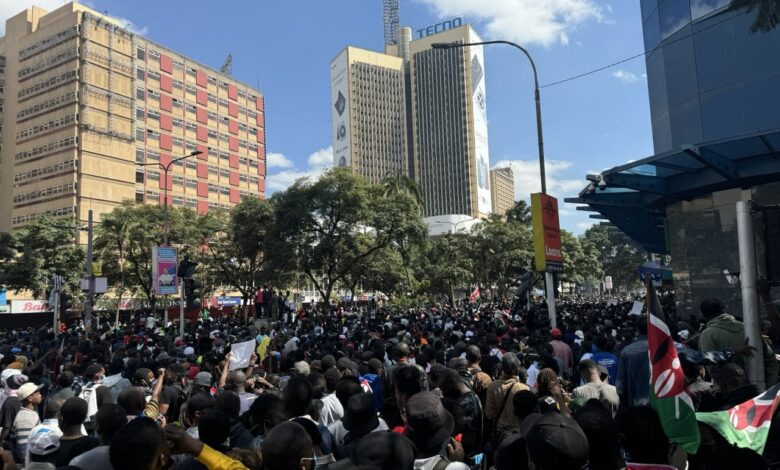
Kenya’s government has unleashed unprecedented restrictions on media coverage and internet access as thousands of Gen Z-(ote) protesters took to the streets on June 25, 2025, marking the first anniversary of the deadly anti-Finance Bill demonstrations. The Communications Authority of Kenya ordered all television and radio stations to halt live coverage while implementing coordinated restrictions on Telegram messaging services, creating a digital blackout designed to suppress information flow during the politically charged anniversary protests.
Why Gen Z Are Protesting Again
The June 25, 2025 demonstrations commemorate one of the most significant moments in Kenya’s recent political history. Exactly one year ago, young Kenyans stormed Parliament during massive protests against the controversial Finance Bill 2024, resulting in at least 60 deaths and over 20 disappearances at the hands of security forces. The protests were driven by widespread discontent over excessive taxation, poor governance, corruption, and lack of accountability from President William Ruto’s administration.
Despite President Ruto withdrawing the Finance Bill following the protests and disbanding his Cabinet, public anger has only intensified. Young Kenyans remain frustrated with the government’s failure to address youth unemployment, rising living costs, and ongoing police brutality. The recent death of blogger and teacher Albert Ojwang while in police custody has further inflamed tensions, with six individuals including three police officers facing murder charges in connection with his death.
Trending Hashtags Drive Digital Resistance
The protests have been largely organized through social media platforms using two primary hashtags that have gained massive traction online. #SiriNiNumbers, meaning “The secret is in numbers” in Swahili, has dominated Kenyan social media throughout June 25, with hundreds of thousands of mentions on X (formerly Twitter). The hashtag is being used to share personal stories, amplify calls for justice, and document events in real time through photos of protest signs and firsthand videos of street marches.
The second major hashtag, #RutoMustGo, continues to trend as protesters demand President Ruto’s resignation. This hashtag reached its peak on July 2, 2024, generating nearly 17 million interactions and over 800 million impressions. The hashtag remains a rallying cry for young Kenyans expressing their frustration with the current administration.
Digital platforms have become crucial organizational tools, with protesters using X and TikTok lives to share protest routes, legal support contacts, and safety guidelines.
Government’s Unprecedented Media Clampdown
The Communications Authority of Kenya issued a sweeping directive on June 25, 2025, ordering all television and radio stations to immediately cease live coverage of the ongoing demonstrations.The directive, signed by CA Director General David Mugonyi, cited alleged violations of Articles 33(2) and 34(1) of the Constitution and Section 461 of the Kenya Information and Communications Act as justification for the media blackout.
The authority warned broadcasters that failure to comply would result in regulatory sanctions, including potential suspension or revocation of broadcasting licenses and disabling of transmission signals. This threat was immediately acted upon, with both NTV and KTN television stations having their free-to-air signals physically cut by the authority after refusing to comply with the directive. The stations confirmed their signals were “unconstitutionally switched off” while they continued streaming content through online platforms and YouTube channels.
Kenya’s major media organizations responded with unprecedented defiance to the government’s blackout orders. The Standard Group issued a firm statement rejecting the directive and announced it was consulting lawyers to establish the legality of the order, which it characterized as an attempt to “plunge the country into a news blackout”. Nation Media Group took an even stronger stance, arguing that the government’s actions represented a clear violation of Article 34(2) of the Constitution, which guarantees freedom and independence of the media.
Telegram Restrictions and Digital Surveillance
International internet monitoring organization NetBlocks confirmed that access to Telegram messaging platform was being restricted across Kenya during the June 25 protests. By 4:00 PM on Wednesday, Telegram’s reachability had dropped to just one percent, essentially blocking access for most Kenyan users across multiple Internet Service Providers.
The restrictions appear to be part of a broader pattern of digital control that began in 2023. The government has repeatedly blocked Telegram during national examinations, implementing restrictions in November 2023 and November 2024 during KCSE exam periods. These actions have been justified by authorities claiming that Telegram channels are being used to circulate examination materials, though critics argue such broad restrictions violate digital rights and lack proper legal justification.
The digital restrictions implemented on June 25, 2025, directly contravene existing court orders. In May 2025, seven civil society organizations filed a constitutional petition challenging state agencies and telecom providers over repeated internet shutdowns. The High Court issued conservatory orders in June 2025, specifically barring respondents from carrying out any “wholescale shutdown, blockage, denial of access or service” affecting internet services or electronic communication platforms.
Ruto’s Absence Speaks Volumes
President William Ruto remained conspicuously absent from Nairobi during the protests, instead retreating to Kilifi County to attend a funeral while thousands of Gen Z protesters filled the streets of the capital and other major cities. His absence during a day of nationwide tension and remembrance did not go unnoticed, especially as police engaged in running battles with protesters in Nairobi’s CBD, Kitengela, Kisii, Nyeri, and parts of Thika Road.
Despite the government’s ban on protests, with Government Spokesperson Isaac Mwaura declaring on Monday that “there will be no demonstrations on June 25” and that it would be “a normal working day”, over 1 Million young Kenyans defied the directive. The protests proceeded across multiple cities, with demonstrators waving Kenyan flags and placards featuring pictures of those killed in last year’s demonstrations while chanting “Ruto must go!”.
President Ruto’s silence on the anniversary protests is particularly striking given his previous defense of police actions. On Tuesday, he had defended the police, urging them to act decisively against what he described as civil disobedience, and warning protesters: “You cannot use force against the police, nor insult or threaten them. You are endangering our nation“.
The anniversary protests have demonstrated that despite government efforts to suppress them through digital restrictions and media blackouts, Kenya’s liberation movement remains resilient and determined. The combination of sophisticated digital organization, constitutional defiance by media houses, and massive street mobilization shows that the struggle for democratic accountability and digital rights in Kenya is far from over. As protesters continue to demand justice for those killed, accountability from their leaders, and protection of their constitutional rights, the government’s heavy-handed response may have only strengthened their resolve to continue fighting for the change they believe Kenya desperately needs.







